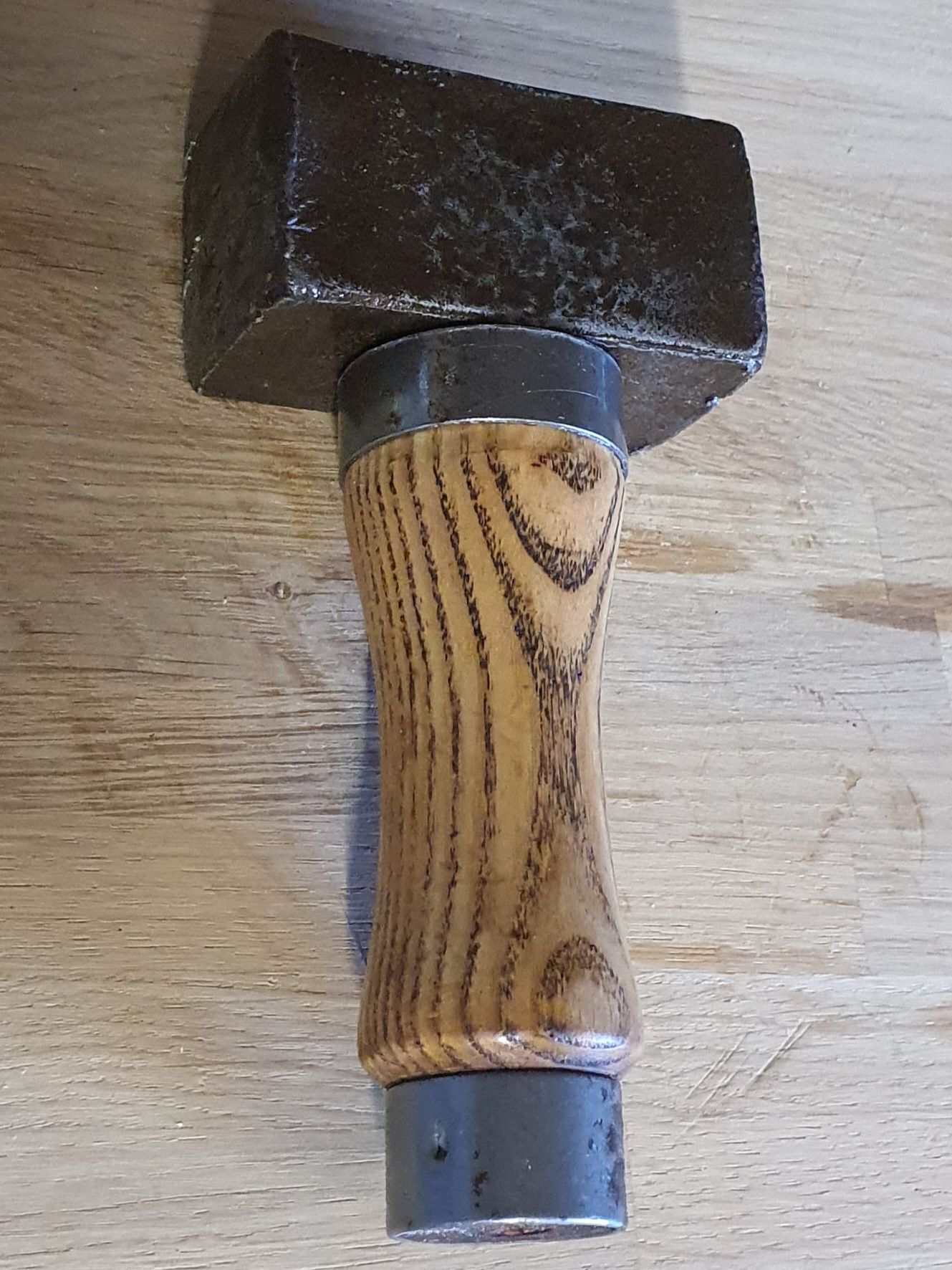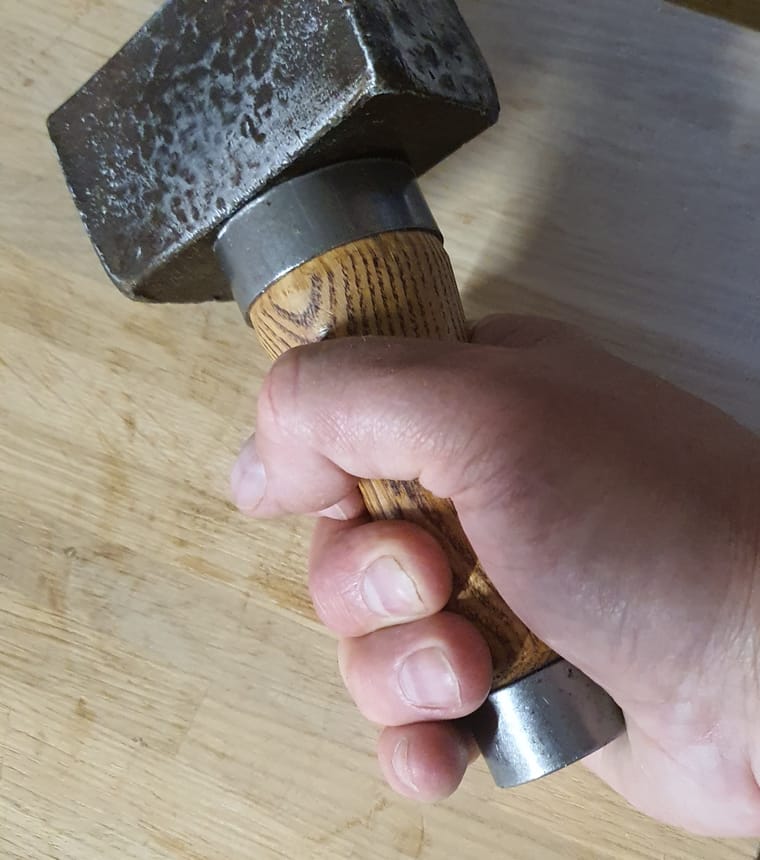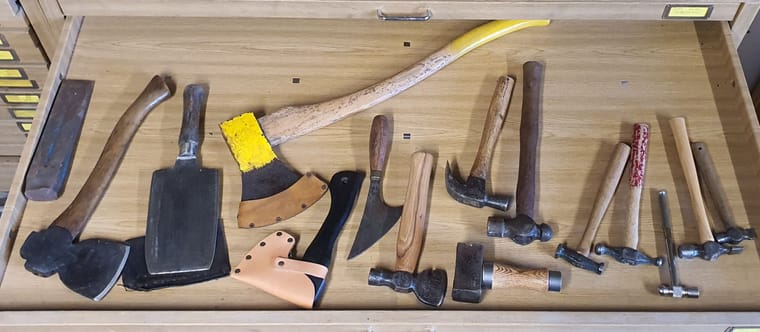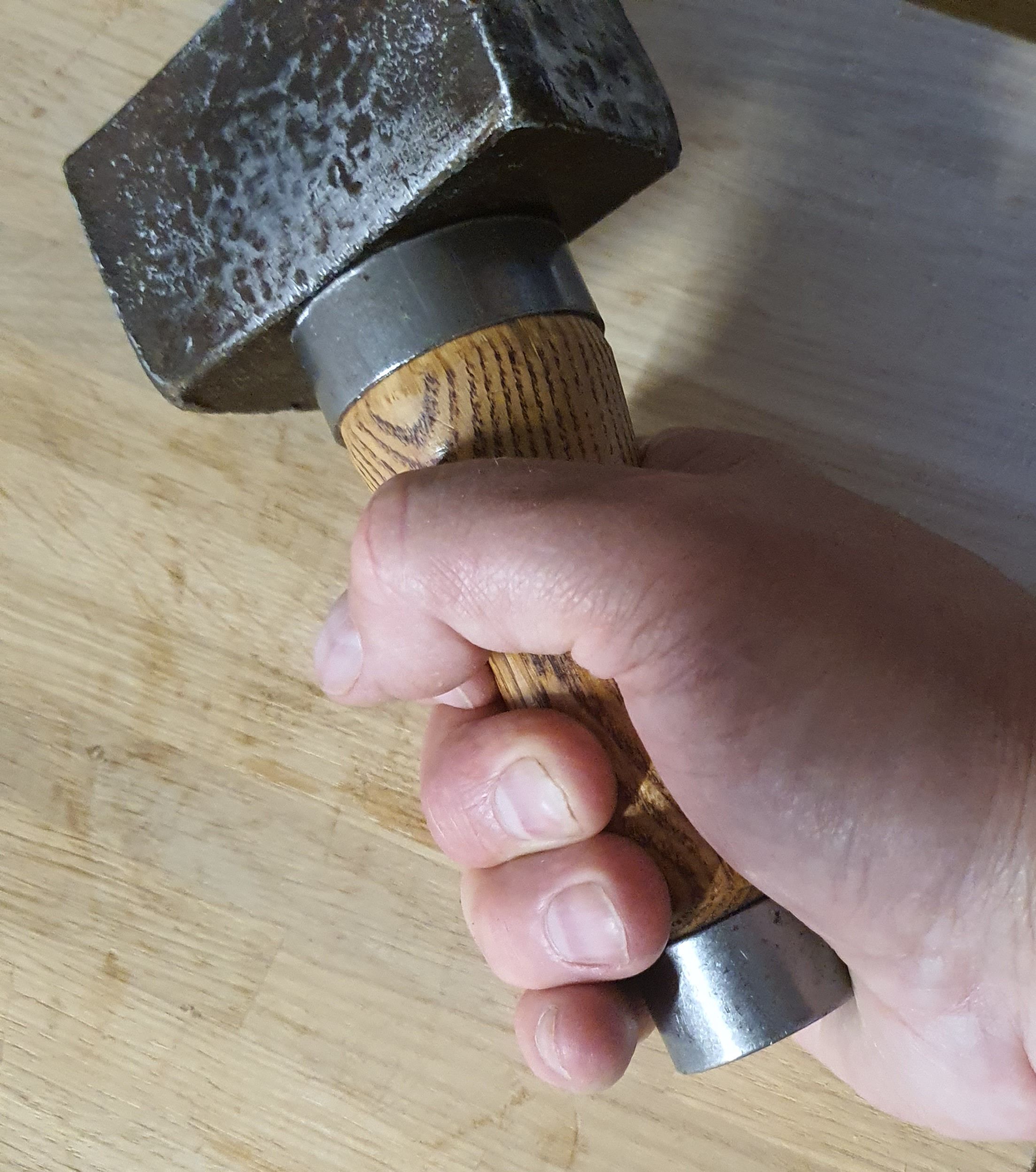Possum skill?
-
@Jolly
Does replacing a knackered hammer handle count? Are they adaptability or simply old country folk skills?So I have 35yr old Alec Tiranti lump hammer, only 2lb but with a short handle has an easy feel and so used for a lot... except for what it is still sold as, a marble and stone carving hammer to chip chip chip.
Anyway the twist is, I adapted a chisel handle (a long, ash, double hooped wood-turning chisel handle bought about 30 years ago).
Cut off the larger end hoop and shaped the handle; first re-fitted the large hoop tight, then head with wood & metal wedges.


New handle is nicer in hand than the original

-
You know, we still have some folks around here who do things the old way. One of my friends is making me a handle for my cant hook(I busted mine).
He told me it's not that hard. Just get a 4x4, five foot-long piece of seasoned hickory, grab a drawknife and whittle off everything that doesn't look like a cant hook handle.

-
Is that oak?
-
Is that oak?
@LuFins-Dad said in Possum skill?:
Is that oak?
Ash.
A good piece of ash is a joy. Stains like oak, almost as strong as oak, but it doesn't end check and it won't dull your tools as fast as oak.
-
Ash is completely different to work, does everything for you easily. BTW I think the handle came from Robert Sorby, still in business.
Next project involves an 8' holly trunk salvaged from a cousins garden. Ever worked holly?Here's my hammer & axe drawer, you may find a few interesting pieces (a railway maul, 14lb sledge and grubbing mattock don't fit)

-
It is cool and they're well kept. Funny how some things are regional or dependent on the age of the user. You almost never see a single-bit ax down here among the older folks, except when it gets down to almost a hatchet.
An exception would be a broadaxe. Sadly, mine was stolen (probably by my daughter's boyfriend, but that's another story). It was my grandpa's and he used it to hew ties. That's why the handle has a little bend, so that you can stand on a log and hew a straight line.
So, I can appreciate the work on the cabinet. That took a lot of skill.
-
@Tom-K said in Possum skill?:
If Jolly likes it, I can't imagine any higher approval. Great job.
True dat!!
-
The felling axe is Canadian and works well, bought new in the 90's. The hatchet is Sheffield made maybe 100 years old. The small one is a brand new japanese carving axe.
If anyone can help identifying the following thing I'd be very grateful:

Made by J V Hill of London (1834-1909), bought from Cornwall. 3mm thick steel all round so is completely blunt.
That's all I know. Any ideas? -
Ash is completely different to work, does everything for you easily. BTW I think the handle came from Robert Sorby, still in business.
Next project involves an 8' holly trunk salvaged from a cousins garden. Ever worked holly?Here's my hammer & axe drawer, you may find a few interesting pieces (a railway maul, 14lb sledge and grubbing mattock don't fit)

@AndyD said in Possum skill?:
Ash is completely different to work, does everything for you easily. BTW I think the handle came from Robert Sorby, still in business.
Next project involves an 8' holly trunk salvaged from a cousins garden. Ever worked holly?Here's my hammer & axe drawer, you may find a few interesting pieces (a railway maul, 14lb sledge and grubbing mattock don't fit)

Wow... Where's the basket for the lotion?
-
The felling axe is Canadian and works well, bought new in the 90's. The hatchet is Sheffield made maybe 100 years old. The small one is a brand new japanese carving axe.
If anyone can help identifying the following thing I'd be very grateful:

Made by J V Hill of London (1834-1909), bought from Cornwall. 3mm thick steel all round so is completely blunt.
That's all I know. Any ideas?@AndyD said in Possum skill?:
The felling axe is Canadian and works well, bought new in the 90's. The hatchet is Sheffield made maybe 100 years old. The small one is a brand new japanese carving axe.
If anyone can help identifying the following thing I'd be very grateful:

Made by J V Hill of London (1834-1909), bought from Cornwall. 3mm thick steel all round so is completely blunt.
That's all I know. Any ideas?Jack the Ripper used the exact same blade...?
-
The felling axe is Canadian and works well, bought new in the 90's. The hatchet is Sheffield made maybe 100 years old. The small one is a brand new japanese carving axe.
If anyone can help identifying the following thing I'd be very grateful:

Made by J V Hill of London (1834-1909), bought from Cornwall. 3mm thick steel all round so is completely blunt.
That's all I know. Any ideas?@AndyD said in Possum skill?:
If anyone can help identifying the following thing I'd be very grateful:

Made by J V Hill of London (1834-1909), bought from Cornwall. 3mm thick steel all round so is completely blunt.
That's all I know. Any ideas?I wonder if it is a leather working tool of some sort?
-
I asked ChatGPT:
Thanks for the details and the photo—very helpful.
Given the unique shape, blunt edge, and maker (J.V. Hill of London, active in the 19th century), this object appears to be:
A leatherworker’s or cobbler’s tool, possibly a blunt paring or creasing knife, or a leather shaping/skiving tool.
Here’s why:
• Curved blade: The exaggerated curve is characteristic of tools used for controlled shaping or smoothing, rather than cutting.
• Blunt edge: A deliberately dull edge would make sense if it’s used for creasing, folding, or burnishing leather, not slicing it.
• Handle style: That turned wooden handle and brass ferrule were typical of high-quality craft tools from that era.
• Origin: Cornwall had a strong history of both mining and leather trades; a tool like this could easily be linked to saddlery or shoemaking.If the blade is completely blunt, then it was almost certainly not meant for cutting but rather for pressing, folding, shaping, or forming material—leather being the most likely.
-
About J.V. Hill
J.V. Hill was a respected 19th-century London toolmaker known for producing high-quality woodworking and leatherworking tools. His products included molding planes, saws, and specialized tools for trades such as shoemaking and saddlery.
Possible Function of the Tool
Given its 3mm thick, blunt steel construction, the tool was likely designed for:
• Creasing or folding leather: Creating decorative or functional lines in leather goods.
• Burnishing edges: Smoothing and polishing the edges of leather items.
• Shaping leather: Forming leather into desired shapes without cutting.Such tools were essential in trades like shoemaking and saddlery, where precise shaping and finishing of leather were crucial.
-
@Renauda, jon-nyc
You cracked it, leather working. Many thanks for the information.
I'd wondered initially if it was for shaping lead or tin, Cornwall being famous for those, but it's too light for metals so was thinking maybe for trimming slate roofing tiles. Hence been in the axe drawer.It is a vicious looking thing until you feel the edges. Sharpened and fixed to a 4' staff it would be like a Game if Thrones weapon for Aria to weild.



